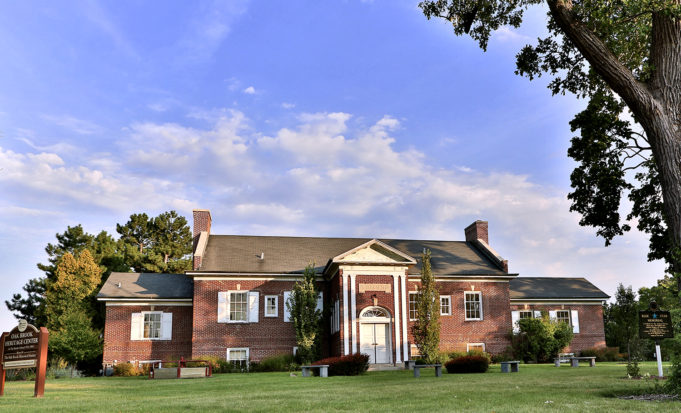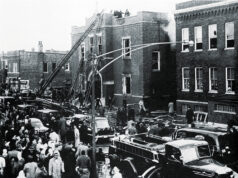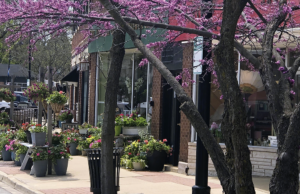By Larry Atseff
Kathy Maher, up until June 2021, was the President of the Oak Brook Historical Society. She has been a volunteer since 1978, shortly after the group began in 1975. Since being elected President in 2006, she has served as primary curator of the history of Oak Brook. Eventually, she is moving away, but before she does, we sat down, appropriately, in the basement of the original Butler School at 31st and Spring Road, to learn how she has led the effort to properly record the official history of what has become Oak Brook, and what she hopes for the future preservation of the heritage of the village. To begin with, she wrote a succinct record called Old Butler School History,1921-2008. Here are excerpts: “Frank Osgood Butler, son of Julius W. Butler who founded the J. W. Butler Paper Company in 1844, in St. Charles, Illinois, moved to Hinsdale in 1890 and built a home on First Street. In 1898, Frank O. Butler bought a farm located on 31st Street at Salt Creek and called it Oak Brook Farm. The farm was developed as a summer home and a horse farm. Adjacent to the Butler property was Natoma Dairy owned by George B.Robbins. Natoma Dairy gained fame by being one of the first to supply “certified milk”.
In 1908 Natoma was sold to Frank O. Butler who continued to operate the dairy and improve production and the level of sanitation. Gradually, he added more and more of the surrounding lands to his holdings. The land was used for feeding the cattle brought from the Butler Company ranch in South Dakota.” “In circa 1921, Frank O. Butler donated 10 acres of land, adjacent to the Natoma Dairy lands and he funded construction of a building to replace one room Rabbit Hill School and one room Torode School. She noted he had one stipulation: “Ownership would revert to him if the school did not meet state standards as a “superior” school. For 40 years it provided a supportive climate for the growth and development of academic excellence at the elementary level.” We learned that the building was built in a Revival Georgian Style as a two-room schoolhouse. Much of the early history of the building was lost in a flood. Nevertheless, in talking to students who attended the school, she learned that one room was for grades 1-4, and the second room was for grades 5-8. Her record observes, “Subjects included: English, history, geography, math, science, art and gym. Music was taught by a traveling music teacher who would visit the school once a week. The piano was in the basement room, which also served as an auditorium, gym and meeting room. Other activities were plays, square dancing, dodge ball, basketball, and ice skating in the winter during recess. Class size ran about 52 students for 40 years.” Her history states, “The Butler School became the “hub” of virtually every activity in the area from 1921-1961. The adults and children attending the school formed a Community Club that met in the basement of the schoolhouse.
During the 1920’s-1930’s, social activities included square dancing, potluck suppers, plays, music recitals, card games, Bunko, a dice game, and pig roasts. Softball ball games, soccer games and ice-skating were held outside.” “From 1941-1945, a Civil Defense organization was created to cover the area served by the school. Members of the Community Club volunteered themselves for this effort. The organization took the name of the Oak Brook Civic Association, the first use of the words “Oak Brook” to define the specific geographical area.” “The Civic Association utilized the Butler School as its headquarters with offices for Air Raid Wardens, a Ration Board, the Draft Board, a 4-H Chapter and Red Cross Chapter. Volunteers made thousands of bandages for wounded soldiers in the basement area. Social activities continued, but the meetings became more formal and far more serious.” “In 1945, after World War II ended, the Oak Brook Civic Association decided to continue under the name and became the “quasi-government” organization, as the population of the unincorporated area between Hinsdale and Elmhurst began to change from a farming community to an equestrian community. Planning began in the mid-1950’s for the creation of a tollway system that would change the area forever. The completion of the Tri-State and East-West Tollway in 1958 forced the incorporation of the Village of Oak Brook. Marshall Field’ s purchased land for a shopping center and a corporate corridor and residential development were being planned.” “It was evident that the Butler School was not adequate to handle the proposed increased enrollment. In 1960-61, a new seven-room Butler School was built on ten acres of land that Paul Butler, son of Frank O.Butler, traded for the original Butler School. Paul Butler then leased the original building for $1.00 a year to the Village from 1961-1965. The building and surrounding land were purchased in 1965 for $130,000 by the Village of Oak Brook.” “The Village of Oak Brook has used the property as a Village Hall, Police Station, and the initial location of a Library. The two classrooms were remodeled into a Boardroom with offices for the Village Manager, Clerk and Building Department on the upper level. The basement was remodeled into a Police Department for the new Police Chief and three patrolmen. One room was allocated for a Library on the Upper floor. Volunteers built shelves, cataloged donated books (approximately 300 in the beginning) and operated an “on your honor” free public Library.” “In the 1970’s the rapid growth of the Village of Oak Brook necessitated the building of a new Village Hall and Police Department.
When the new Village Hall was completed in 1975, the historic building was converted entirely to Library use.” “A new modern Library was constructed in 2000-2001. The Village of Oak Brook continued to use the Butler School for offices during construction of the expansion of the current Village Hall.” In sum, “The Old Butler School building has served as an educational facility for 40 years, a Village Hall for 15 years and a Library for 26 years. It was placed on the National Register of Historic Places in 2003.” You can go to oakbrookhistory.com to read her full account. We asked, what’s ahead for the building and the organization for the next 100 years? She says, “First of all, we are evolving the organization and the building to be named the Oak Brook Heritage Center. This is a more apt description. It covers not only Oak Brook’s history but will carefully record the future to better preserve the entire heritage of the community going forward.” “We have been repairing and restoring the building to its original condition. Thanks to many volunteers, we have been slowly, but surely, organizing the archives into much better shape than they have ever been.
When our leaseholder, the Village of Oak Brook, installs a new HVAC system to replace the 40 yr. old, unreliable system, the Historical Society will be able to, once again, serve the community through multi generational programming.” “Under newly elected President Lisa Griffith’s direction, we will be creating displays of a substantial collection of artifacts of the history of Oak Brook. OBHS will also be able to hold their popular annual events, like the Veterans Day Commemoration, at the 100 yr. old historic Heritage Center. There will be new events added, such as ‘Historical coffee talks.’ When funds allow, the addition of an archivist, and an intern have been proposed. As a volunteer, Kathy hastens to add, “There is still much to do and additional volunteers are needed for creating events, further researching important Oak Brook people and events, continuing the archiving of files, and, of course, fundraising for further restoration. Oak Brook has an interesting, exciting and colorful history that, unfortunately, is unknown to most Oak Brook residents. The stories of the early pioneers are fascinating and those of the men and women who founded Oak Brook in 1958, and the work they did in setting up a Village ‘from scratch’ are absolutely inspiring! I have been truly blessed to learn many life lessons from reading about their struggles, failures and successes.”















